In autumn, the peony requires more attention than in spring or summer.
Proper care during this period helps to ensure bright bloom next season.
It's time to prepare the peony for winter.
What you need to know about autumn peony care
In autumn, the plant needs additional nutrition, which is the key to flowering in the future, and also helps to accumulate required amount nutrients for a good winter. How to prepare a peony for winter?
Peony feeding
All fertilizers are applied in the fall before the onset of frost, somewhere in mid-September or early October. But in the northern regions you need to look at the weather. Why fertilize a peony in the fall? The root system of the plant has some features; it actively grows in autumn. Peony care during this period should be complete.
As a rule, phosphorus-potassium fertilizing is applied in autumn, leaving nitrogen fertilizers for spring application. The use of such a feeding scheme gives the following advantages:
In the next season, larger and better buds appear;
Peony bloom will be full, brighter and more memorable;
In response to the received top dressing, the bush begins to grow actively, increases in size.
Fertilizers are applied in several ways:
in liquid form;
Dry way.
If the weather is dry, then it is better to make liquid root dressing plants. To do this, mineral fertilizers are dissolved in water, the bush is watered with the resulting solution. The consumption of the working mixture is 1 liter per plant, depending on its size.
Rainy autumn dictates its own rules, and it is better to apply fertilizer in a dry form. The point is that the application liquid fertilizer unjustifiably. When the soil is waterlogged, root system stops absorbing useful material from her. Dry granular top dressing will come to the rescue. They last longer, and the minerals come in doses. A handful of granules are scattered around the shrub, lightly embedded in the soil.
Peony care: autumn pruning
So that the neighbors in the country would not advise, but pruning of the peony should not be postponed until spring. It is carried out in autumn. crop above-ground part shrub is better with the onset of the first frost. Sometimes, it falls at the end of October or the beginning of November. But every region is different.
Important! Earlier pruning of a peony weakens the plant, it will not tolerate winter well, which will affect further flowering.
How to prune a peony? You need to trim the shoots at ground level, slightly deepening the tool into the soil. All garbage is removed from the site and burned, this will avoid contamination of the earth with various diseases. The place of cuts and the bed are sprinkled with wood ash.
How to transplant peonies in autumn
Autumn - best time for reproduction and transplantation of peonies. This procedure is carried out in late August - early September. The soil for planting delenki is prepared in advance. To do this, they dig a hole, about 60 cm in size. The root system of the peony grows in breadth, which should be taken into account when planting. The distance between plants is left sufficient for their development. The optimal interval is about 50 cm to 1 meter.
The first layer in the planting hole will be drainage. It is equipped with sand or broken brick. The thickness of the drainage layer is up to 30 cm. Next, there is a layer of nutrient soil with the addition of fertilizers. Humus, ash, compost, potassium sulfate, superphosphate are added as top dressing. The thickness of this layer does not exceed 30 cm. Then the hole is filled with soil and left for a week. During this time, the earth will sag, compact, which in the fall is important for the proper planting of peony rhizomes.
Important! It is highly not recommended to deepen the rhizomes during planting, since as a result the flower bed will be left without flowers. The shrub will grow a lot of lush greenery, but will not produce buds.
It should also be remembered that in the first year after planting, the peony will not bloom. But at the same time, the plant should look healthy, and not lethargic. Buds will appear when the maturity of the plant comes. But if in the third year of cultivation they are not, then you need to look for errors.
Reproduction of peonies in autumn
Peonies are long-lived in a flower bed, so their transplantation is extremely rare. It is done once every ten years. During this time, the shrub will grow and require division. This is the best way to propagate peonies.
However, old rhizomes do not tolerate transplantation well, the resulting plants are inferior to others in all qualities. Experienced gardeners it is advised to propagate shrubs after 4-5 years of cultivation. The resulting young peonies meet all quality standards. Their flowering is distinguished by pomp, and the bushes are attractive in appearance.
Transgress to the procedure for dividing mother bushes better in autumn. As a rule, the peony is propagated in September. But no later than a month before the expected frost.
How to prepare a plot for planting?
In autumn, the mother bush is dug up, carefully removing it from the ground. The rhizome is shaken off the ground and washed, trying not to damage the growth buds. Old shoots are cut to the very root. The prepared rhizome is left to dry for outdoors until it becomes slightly soft. Such a root can be divided without much damage.
Starting to divide, the rhizome is well examined. All areas with voids are cut off, and the cut points are washed with disinfectants. After dividing the old root, several seedlings are obtained, each of which has well-developed growth buds. It is important that the plots are the same size, as too large plots take longer to get sick after transplantation, and small ones die.
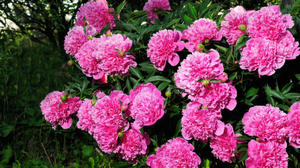
Peony planting is carried out in the usual way, not forgetting about the shelter of young plantings.
Preparing for Winter: Sheltering Peonies
Pruning and top dressing are not all the features of caring for a peony in the fall. The plant needs quality shelter, especially in regions with harsh winters.
The depth of the peony growth buds is at the level of 3-6 cm from the surface of the earth. Therefore, with the onset of cold weather, the shrub needs to be spudded.
sawdust;
Lapnik;
dry foliage;
Humus.
You can not use the cut shoots of the peony itself for shelter. They attract pests and are a breeding ground for most bacteria.
A shelter for a peony is formed with a thickness of about 15-20 cm. This allows you to save the plant from severe frosts and cold winds.
Summing up
Autumn peony care is not too complicated, it consists of a number of necessary activities:
top dressing;
pruning;
Transfer as needed;
Shelter and mulching.
If all the actions were performed correctly and on time, then you can not worry about the safety of peonies in winter. Spraying the soil and shrubs with copper sulfate will help prevent the appearance of fungal diseases. It is important to remember that fungal spores overwinter in the foliage, so they always keep order in the flower bed. Do not forget that in harsh winters, snow will help to further insulate the flower bed, which will only benefit the plants.
In general, peonies are considered pretty undemanding plants. They only need systematic watering, weeding, loosening the soil and top dressing, as a result of which you will enjoy beautiful rich flowering in summer time. It is believed that the main care is carried out during the period of active growth and flowering of flowers. However, peonies are perennial plants, so with the advent of autumn they will need special care, which is a guarantee that they will next summer pink, yellow, bronze or burgundy buds will bloom in your flower bed. Therefore, we will tell you about what to do with peonies in the fall, how to prepare them for the winter cold.
Autumn peony care: top dressing
Since peonies respond well to fertilization, it is necessary to fertilize peonies in the fall. It is recommended to do this in September or early October. The fact is that in these garden pets the root system has a number of features of growth and structure. In some areas, the roots of peonies thicken, it is there that the necessary nutrients accumulate, which are delivered by long roots that penetrate deep into the soil. Peony roots continue to grow in the first half of autumn, which is why additional feeding is so necessary for plants.
If we talk about how to feed peonies in the fall, then it is usually recommended to use potassium-phosphorus fertilizer, which will promote the development of new buds. Their stimulation means beautiful flowering next year. Feeding can be carried out in dry and liquid form. In the first case, 15-20 g of phosphorus and 10-15 g of potassium should be carefully sprinkled on the soil near each bush. Do not forget to water the peony well beforehand. Make sure that the fertilizer does not get on the neck of the peony. To prepare the solution in a bucket of water, dissolve 1 tablet of fertilizer and pour the bush with this solution.
Autumn peonies care: pruning and preparing for winter
Basically, autumn care for peonies involves pruning shoots. Before winter, it is required. If you leave pruning for spring, you will have a hard time: softened shoots are difficult to cut with secateurs. It, as a rule, must be carried out in late autumn, at the end of October - at the beginning of November. The fact is that if you do this earlier, the plants will become weaker, and this, in turn, will affect its flowering next year. It is recommended to perform such peonies pruning in autumn after the first frosts appear, when the peony shoots begin to lie down on the soil.
When pruning favorite flowers, shoots should be cut at ground level so that no stumps remain. If you intend to carry out autumn peonies pruning in dry weather, do not forget to water the basal soil abundantly. All cut shoots and leaves must be removed from the lawn and burned, as they can become a source of various diseases. Many gardeners advise after pruning to add a mixture of 200 g of bone meal and 300 g of wood ash.
How to care for peonies in autumn: preparation for winter
In the autumn care for these garden flowers, it is important to prepare for severe frosts. This is recommended for areas where 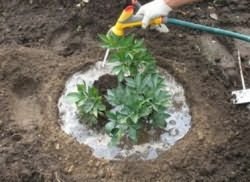 severe winters are expected. First, check the depth at which the kidneys lie in the kidney. It should be no higher than 3-6 cm, if necessary, pour a small layer of soil on top. Each plant needs to be covered with any of the materials you have available: sawdust, fallen leaves of trees, peat or compost. But, in no case do not use leaves cut off at the peony itself - this can become an excellent environment for the development of fungal diseases, and, of course, lead to death. Please note that for good protection against severe frosts, the height of the coating should be at least 10-15 cm.
severe winters are expected. First, check the depth at which the kidneys lie in the kidney. It should be no higher than 3-6 cm, if necessary, pour a small layer of soil on top. Each plant needs to be covered with any of the materials you have available: sawdust, fallen leaves of trees, peat or compost. But, in no case do not use leaves cut off at the peony itself - this can become an excellent environment for the development of fungal diseases, and, of course, lead to death. Please note that for good protection against severe frosts, the height of the coating should be at least 10-15 cm.
Carrying out such necessary measures to care for a peony in the fall is a guarantee beautiful flowering in summer time.
womanadvice.ru
How to care for peonies so that they always give gorgeous blooms
How to care for peonies so that they decorate the garden every season bright colors? Peonies are perennials and in one place without a transplant can be several decades. These flowers have been known since ancient times, many legends have been created about them, and now they are considered the most popular. garden plants. They are divided into species such as herbaceous and tree peony.
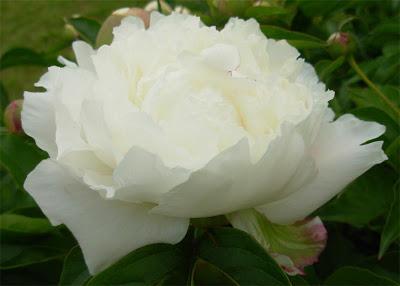
Herbaceous peonies and their care
Herbaceous species are divided into: medicinal, Caucasian, Crimean, narrow-leaved, evasive and many others. Herbaceous peonies do not require special care, landing is best done on spacious and sunny places. Constant moisture in the ground will lead to the death of rhizomes, so these plants should not be placed in low and damp areas. For good growth flowers, the soil should be filled with peat, sand, humus, but only peat soil should be avoided, it must be diluted with sand and ash. We will also talk about how to care for peonies after planting, because it is important that young plants take root quickly and bloom profusely.  For these plants, the main rules of care will be watering, fertilizing and loosening the soil. During the flowering period, it is necessary to remove the buds on the peduncle, and leave only one flower. Also, one of the stages of care will be the removal of dry buds to avoid various diseases. IN autumn period cut off all the leaves completely, then you need to fertilize and loosen the soil. And how to care for peonies in the spring? First of all, we open the bushes after the winter period, we apply fertilizer as soon as the first sprouts appear from the ground. The second time we carry out top dressing during the budding of the plant. Even the youngest gardener can grow this flower, and you already know how to care for peonies.
For these plants, the main rules of care will be watering, fertilizing and loosening the soil. During the flowering period, it is necessary to remove the buds on the peduncle, and leave only one flower. Also, one of the stages of care will be the removal of dry buds to avoid various diseases. IN autumn period cut off all the leaves completely, then you need to fertilize and loosen the soil. And how to care for peonies in the spring? First of all, we open the bushes after the winter period, we apply fertilizer as soon as the first sprouts appear from the ground. The second time we carry out top dressing during the budding of the plant. Even the youngest gardener can grow this flower, and you already know how to care for peonies.
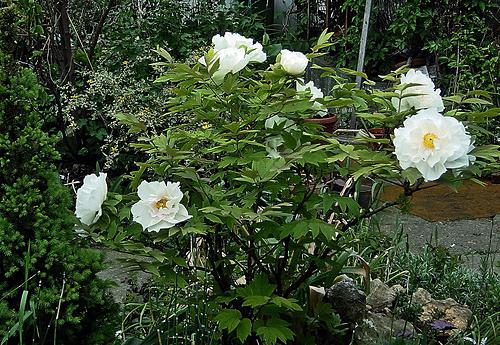
Caring for tree peonies
One of the species of these plants is a tree peony. It is a tall shrub with bright green leaves and many flowers. Sometimes several dozen buds can bloom on one bush. What are the features of this species and how to care for tree peony? This will be discussed further. First, the successful growth of any plant can be achieved by proper planting. This type of flower is best repotted at the end of the summer season or early autumn. A place for planting must be chosen protected from the wind, the soil must be drained. It is best to use wood ash, bone meal and minerals rich in phosphorus and potassium, but low in nitrogen, for fertilizer. Top dressing is carried out twice per season, a few weeks before flowering and after it. Abundant watering the plant requires only in spring period if there is not enough moisture in the soil. During the awakening of the kidneys, the peony bush should be cut off, which will form good shape and rejuvenate the plant. These beautiful multi-colored and lush flowers will draw admiring glances to your garden, and our information will help you how to care for peonies.
fb.ru
Peony care. After flowering, the plant should restore strength
Peonies are strong hardy plants with beautiful carved leaves and fragrant flowers. They are very decorative and serve as a decoration for any garden. The buds begin to bloom in early June and delight us, depending on the variety, until mid-summer. Bushes bloom very profusely and can lie down under the weight of their heads, so they need to be tied up. Only non-double peonies can do without support.
Care
In the spring, as soon as the snow melts, it is necessary to water the plant with a solution of potassium permanganate. This will help protect young shoots from rot and stimulate the development of the root system. When sprouts appear, they must be treated with Bordeaux liquid. Further, the plants need careful loosening, weeding and fertilizing.

During the summer, peonies are fed 3 times: at the beginning of growth, at the stage of budding and after flowering.
They do not tolerate stagnant water in the roots, but need twice a month good watering. Especially at the end of spring, during rapid growth, and in the middle of summer. It is very important to ensure proper care for peonies after flowering. In these month and a half, new buds are laid, and the plant should receive enough moisture and nutrients.
Before frost, the aerial part is cut off at the base, plant residues are burned.
How to get big flowers
This can be achieved by plucking the buds on the side shoots while they are still the size of a pea. It is necessary to leave one head on one peduncle so that it develops in full force. 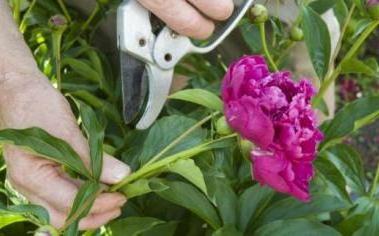
From the bush, you can take no more than a third of the flowers for a bouquet, the rest must be left. It is important to preserve the vegetative mass of the plant and cut the stems only 1/3 of their height. Caring for peonies after flowering consists in removing falling petals - once on the leaves, they can provoke fungal diseases.
Young specimens under the age of 3 years should grow the root system, so the buds are completely removed from them. The richest flowering occurs at the age of 4-10 years, although the bush can successfully grow in one place up to 60 years.
A place under the sun
Sometimes plants develop well, but form very few buds. They receive enough moisture, all the necessary fertilizers, peonies are also cared for after flowering in accordance with all the rules, but the result of the efforts remains modest. What's the matter?
Peonies love the sun. Even 2-3 hours of shading per day can be bad for them. They are not planted near the walls, in tree trunks, next to buildings. Peonies are suitable only for open sunny areas.
Soil Requirements
Peonies are unpretentious, but they have their own preferences. They grow best in cultivated, well-drained loam. The reaction of the soil should be neutral. Caring for peonies in the country should include periodic measurement of acidity, since the earth usually acidifies when fertilizing. If necessary, the soil must be limed.
Peat has an acidic reaction, peonies do not like it either in the form of fertilizer or as a mulch.
How to feed peonies
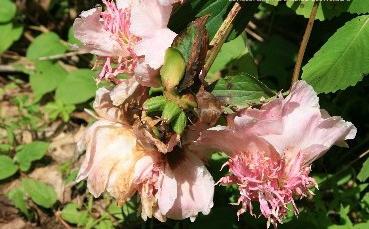
Top dressing begins from the first year of planting - from the moment the sprouts appear until the end of June. It is best to use mullein. It is diluted in a ratio of 1:10 and poured into grooves previously spilled with water around the bush. Then they are sprinkled with earth.
The mullein can be replaced by the application of a complete mineral fertilizer, it is also able to provide complete care for peonies.
After flowering, the plant needs phosphorus and potassium to strengthen tissues. They are also brought into the groove, then moistened and covered with earth.
Twice during the summer, peonies can be sprayed with Epin or Zircon preparations.
fb.ru
Peony care before and after flowering
The noblest and one of the most beautiful of the cultivated flowers, the peony has long served as a symbol of love, wealth, prosperity. And what needs to be done to make this symbol feel good, bloom and smell fragrant annually, bringing only joy with its presence on the site?

Caring for a peony is not at all difficult.
Most of the success is guaranteed by the correct landing in a well-chosen place.
Spring care.
In early spring, as soon as the dark red shoots begin to sprout, a layer of mulch material is carefully removed from them. Loosening is carried out next to the bush, quite shallow, so as not to damage the fragile buds. At a distance of 10-15 cm from the bush, loosening should be deeper. It retains moisture and kills weeds. Most of all, peonies do not like the neighborhood with thistle and wheatgrass. Loosening should be carried out after each major rain or watering.
In spring, plantings can be mulched with a small layer of well-rotted horse manure. Mulching with leaf compost or straw is not allowed, as they can infect peonies with a wide variety of fungal diseases. If the diseases have already begun, then any organic matter is generally excluded from both top dressing and mulch.
Watering is especially necessary in the spring before and after flowering, especially if the weather is dry. Watered no more than once a week, but thoroughly wetting the roots, up to 3-4 buckets of water per bush. It is better to water with a hose, under the roots or along the grooves. hit excess moisture on stems and leaves can provoke putrefactive diseases, and on flowers it immediately leads to blackening and falling of the petals.

Top dressing.
Fertilizers are needed mostly phosphorus-potassium. Nitrogen is more needed in the spring, but its excess leads to a weakening of the plant's immunity.
It should be borne in mind that acidic soil is not suitable for peonies at all, pH = 6.5-7 is best. On too acidic soil carry out liming. To prevent diseases, the soil is sprinkled with wood ash, about half a cup per bush.
In the spring, liquid complex top dressing is carried out twice: ammonium nitrate, superphosphate, potassium sulfate, 20 g each per bucket of water, and adding 1 liter of manure infused in water, preferably horse. This solution is enough for 2-3 bushes. After flowering, only phosphorus-potassium fertilizers are used to lay flower buds for the next season.
Bushes older than 7-10 years old have fewer young suction roots and absorb substances from dressings worse, so they make additional recesses around the roots, digging in pieces of pipes or cut plastic bottles, along which they pour nutrient solutions to the roots.
The first years after planting.
In the first and second year of life, peonies grown from delenok usually do not bloom. If they nevertheless begin to form buds, then they are not allowed to bloom, removing the buds while they are the size of a pea. All the forces of young plants should be directed to the main thing during this period - the formation of a large number of strong healthy roots, this is the key to the future. abundant flowering. It begins from the 3rd year of a peony's life, reaching a maximum by 5-7 years of age.
Plants older than 10 years are divided for rejuvenation so that the flowers do not shrink.
For the first couple of years, newly planted peonies can not be fertilized at all, because there are still enough nutrients in the planting hole.
Care of adult peonies.
Annual care for adult peonies is more thorough. A powerful well-fertilized bush forms a large number of peduncles. In varieties with large double flowers flower stalks under the weight of the petals can bend and fall to the ground. To prevent this from happening, pegs are dug around the bush, on which horizontal crossbars are attached, so that inclined branches rest on them. Tying directly to the pegs or tying the bush into one bundle is not practiced, as it has a bad effect on flowering, and it does not look aesthetically pleasing.

Care for peonies after flowering.
Flowering is a period of admiring peonies, but even at this time they need close attention. When several buds are formed on one peduncle, one main bud is left, the rest are removed so as not to take strength from the main one. Faded flowers are removed, but under them you should try to leave maximum amount leaves. If the plant is used for cutting, then no more than half of the flowers can be taken from the bush. Any crumbling petals that can rot and cause disease should be removed.
In autumn, when cold weather sets in, all stems are cut as low as possible to the ground, but without touching the buds, and burned. Please note - you can not cut the leaves immediately after flowering! After the peonies have already faded, the leaves continue to work and accumulate nutrients that are important for the successful wintering of the plant and flowering in the next season.
Herbaceous peonies do not require other special agricultural practices after flowering.

Subject to all the rules of agricultural technology, peonies DO NOT SICK. If, nevertheless, signs of gray rot, rust, leaf spot appear, all affected parts are immediately removed from the plant and burned. Additionally, treatment is carried out with such preparations as Bordeaux liquid, Topaz, or blue vitriol. Such treatments are especially relevant at the beginning of pion growth, in spring, and after flowering.
Peonies are almost not affected by pests. Sometimes bronze beetles settle in flowers, eating away the center of the flower and the petals. Beetles are harvested by hand. Sometimes peonies are bothered by ants with their constant companions - aphids.
Please tell me how to care for peonies and how to fertilize them
fivf fivf
I have been growing for many years and only please!
Herbaceous peony is one of the most beautiful and widespread perennial ornamental plants.
They give an excellent cut, are widely used in landscaping. Compactness, slenderness of the bush, delicate aroma are highly valued.
garden classification
Peonies according to the structure of the flower are divided into five main groups.
1. Simple. They have one row of wide petals, stamens and pistils.
2.Japanese. They have one row of wide petals. Stamens with wide filaments.
Z. Aneloid. They have one row of petals. The stamens are colored in the same way as the petals.
4. Semi-double. They have several rows of petals interspersed with stamens.
5. Terry. The whole flower consists of densely planted petals.
blank planting material
Peonies reproduce mainly by dividing the rhizomes. The plant is carefully dug around and from below, without damaging the roots, the earth is removed from them. The leaves are cut from the plant, rotten roots are removed, the old roots are cut at an angle of 45-600 from the inside.
The best division is a part of a bush with 3-5 eyes and with the same number of roots. Bushes divide more easily when the roots are tied.
In the first year of growing peonies, it is necessary to obtain a highly developed root system.
Shelter for the winter
Peonies planted in the ground should, with the onset of frost, be covered with a layer of peat 10-12 cm thick for the entire winter period. Free flowers from shelter in early spring.
Watering, loosening, top dressing
In the first year of development of young plants, infrequent but plentiful watering is necessary. Watering is especially important in spring and early summer, when fast growth bushes and the formation of flowers, and at the end of summer (July - early August), when renewal buds are formed.
Loosening the soil is carried out to retain moisture and control weeds. At proper fit and agricultural technology, plants should be fertilized from the third year of life.
Peonies assimilate the elements of top dressing throughout the growing season. At the beginning of growth, plants need nitrogen most of all, during budding and flowering - in nitrogen, phosphorus and potassium, in autumn - in phosphorus and potassium. .
Care during the flowering period
In the first two years after planting, it is recommended to remove the buds that have appeared so as not to weaken the development of plants. An important agricultural technique is the removal of lateral buds, leaving one central bud on the stem to produce large flowers.
Break off the buds carefully so as not to damage the plant. When cutting peonies, it must be remembered that the growth of renewal buds is carried out due to the nutrients produced by the leaves. At least two or three leaves should be left on the stem. Flowers are cut early in the morning in the bud opening phase.
Location
The area for peonies should be sunny, open, but protected from the wind. Strong shading during the day, even for two or three hours, leads to inferior flowering.
The best soil for peonies is loamy, well-drained soil. These flowers do not tolerate damp, wetlands.
For planting peonies, pits should be prepared in advance so that the soil settles. Landing pits should be at least 50-70 cm long and wide. The bottom of the pit is loosened, two-thirds filled with a mixture of humus, peat and the top layer of the earth. 400 g of bone meal and 200 g of superphosphate are added to the mixture per pit and mixed thoroughly. The upper part of the pit (about 20 cm) is filled with earth from the top layer without fertilizer.
Diseases and measures to combat them
In wet years, gray rot causes great damage. The development of the disease, especially on the roots, is favored by heavy soils, hyperacidity, excess nitrogen fertilizers, thickened plantings, shelter for the winter with manure. The disease affects young seedlings, stems, leaves, buds.
The greatest distribution of gray rot occurs in the second half of summer. appear on the leaves brown spots leaves curl and dry up. Light brown spots also appear on the stems at the base of the shoots.
Good luck!
Personal Account Deleted
manure and more, right on top =)
Personal Account Deleted
shit, droppings and more, I pour goodness on everything so ...
Olga Borisovna
Peonies are very picky. I bought a book on caring for them and immediately found a bunch of answers.
Roxanne
There are fertilizers. And there is a grandmother's way. Soak the bread crusts and pour over.
~VESNA-LETO~
found in culture the following types peonies: Chinese peony with white, pink-white, lilac-pink and dark red double flowers. Peony ordinary (officinalis) - one of the most durable species with red and purple double flowers. It has one bud on each stem, while the Chinese peony has several on the stem. Fine-leaved peony with pinnate decorative leaves. Blooms very early. Flowers non-double and double bright crimson. Peony lutea - bright yellow color and with the smell of a lily. Tree peony in the form of a shrub, with fragrant flowers. Other types of peonies are also cultivated.
Peonies are best planted in open, sunny, well-warmed places, protected from the prevailing winds.
Peonies are propagated by dividing old bushes. Plants can remain for a long time (up to 20 years or more) without a transplant, growing into big bushes, but this requires appropriate pre-plant tillage and care.
On the next year after planting, peony bushes usually develop poorly and do not bloom. Flowering begins in the 2-3rd year and every year becomes more and more abundant. Therefore, plants intended for flowering do not need to be repotted frequently. But when growing planting material, on the contrary, it is not necessary to keep the bushes in one place for a long time. They are dug up after 4-5 years, as young plants divide better.
Peony bushes are planted in holes measuring at least 50-60 cm in depth and in diameter. The bottom of the pit is loosened to the depth of a shovel. The pit is filled 1/2 - 2/3 with a mixture of well-decomposed humus, topsoil and mineral fertilizers. Approximate dose of fertilizers for 1 pit: humus 10 kg, granulated superphosphate 60-100 g, potassium chloride 40-60 g.
The upper third or half of the pit, where the roots will be placed, is covered with a mixture without mineral fertilizers. Landing pits should be done in advance so that the earth has time to settle. Best timing planting peonies - August 15-20. Plants should have time to take root before the onset of cold weather.
When digging bushes to divide them, the stems must be cut to a height of 10-15 cm. The bush is first dug in, then lifted from both sides with pitchforks or shovels, then the earth is washed off with water. We must try to separate the parts of the bush and cut it as little as possible. When dividing large bushes, metal or wooden pegs are used, which are driven into the bush. Small parts separate sharp knife. It is not necessary to divide the bushes very large, because then the roots are poorly formed in the first year.
Small-sized bushes develop slowly at first, but later form good bushes with a healthy root system.
A standard division should have 3-5 buds and 2-3 root tubers. All old tubers, damaged parts must be removed, slices sprinkled with crushed charcoal. It is very important to keep the roots of peonies moist before planting, so immediately after digging them, they must be priko-pat or covered with wet matting or burlap. Very great importance has a seating depth. If planted too deep, the plants do not bloom; if planted too shallow, the buds dry out or freeze out. The planting depth should be such that there is a layer of earth 4-5 cm above the upper kidney. heavy soils and 5-6 cm on the lungs. After planting, the bushes are watered and mulched with peat or humus. Watering is repeated after 5-7 days. If the plants are planted in well-fertilized soil, then they can not be fertilized in the first 2-3 years.
Many flower growers complain that the old peony bushes have stopped blooming. It comes from a lack of nutrition. 4-5-year-old bushes should be fertilized annually in the spring with well-decomposed humus, superphosphate and potassium chloride. Approximately under 1 bush, 1 bucket of humus, 50 g of superphosphate and 50 g of potassium chloride should be added. Instead of humus, you can water the bushes with highly diluted (1:20) mullein.
During the period of budding, flowering and the formation of renewal buds (July), the plant should be watered abundantly (in dry weather). In early September, watering is stopped.
Peonies are perennial, long-flowering woody-deciduous plants. For their lush and long flowering, the plant needs properly prepare for the winter. In order for the peony bush to please next year with a lush and good flowering, you need to know when to plant peonies - these amazing and luxurious flowers.
 The end of summer-beginning of autumn is the best time to prepare the plant for winter. During this period, the plant can be planted, transplanted and divided, because for summer period the roots of the bush lay the buds of renewal.
The end of summer-beginning of autumn is the best time to prepare the plant for winter. During this period, the plant can be planted, transplanted and divided, because for summer period the roots of the bush lay the buds of renewal.
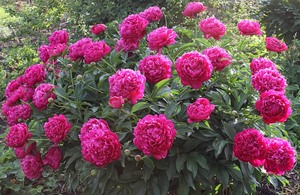 Every novice florist who has peonies in the garden thinks about Do I need to dig up peonies for the winter. The answer is of course no..
Every novice florist who has peonies in the garden thinks about Do I need to dig up peonies for the winter. The answer is of course no..
Every 6-8 years, bushes need only rejuvenate in order to preserve the duration of flowering. This is done in the fall by dividing the bush. The work is not easy. For correct transplant you need to know the basic rules for dividing a plant:
- In autumn, cut the shoots 15 cm from the ground, in order not to be tempted to pull the bush by the stems;
- Dig the bush from all sides, trying not to damage the roots and gently lift it above the ground. The older the plant, the harder it is to do;
- The excavated bush must be washed with water and left in the shade to dry;
- Carefully inspect the root system and remove damaged and rotten roots, and cut the rest by 20 cm;
- Damaged, after digging the rhizome, clean with charcoal;
- Carefully divide the bush into the required amount, trying not to damage the kidney. Each division should have 3-4 shoots;
- Leave the delenki for a day in the shade to form a cork layer that will protect the plant from microbes.
If landing does not occur immediately, you need to know how to save peonies before planting. To do this, the divided bushes must be planted in a pot with moistened and disinfected sand, and installed in a shady, draft-free place. In autumn, the pot is removed into a room with a temperature of 5-8 degrees, periodically moistening the sand.
Overwintered bushes form buds in early March, and in May the first shoots appear.
Gallery: peonies (25 photos)
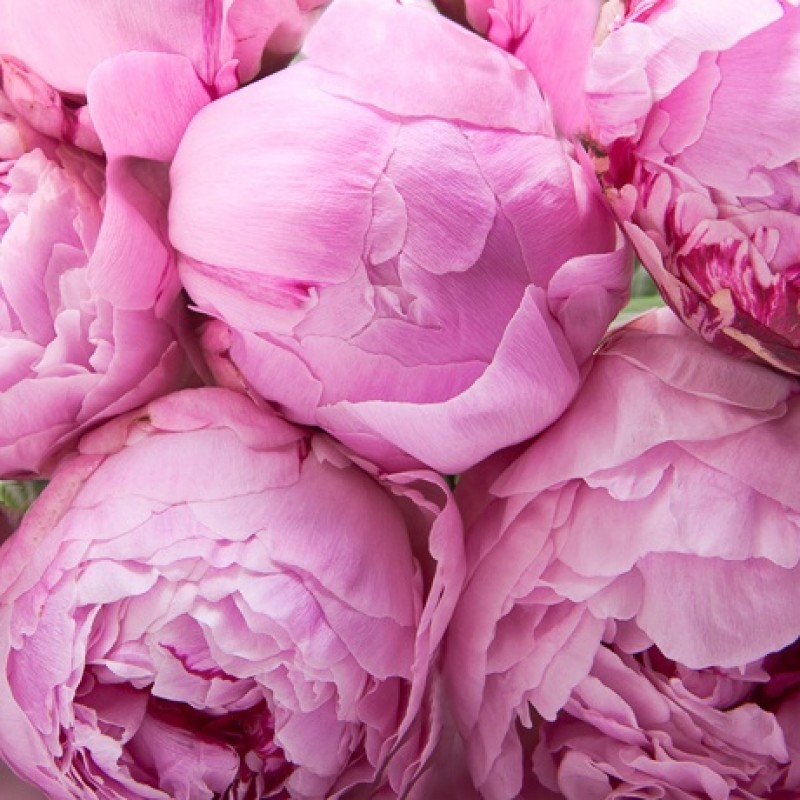



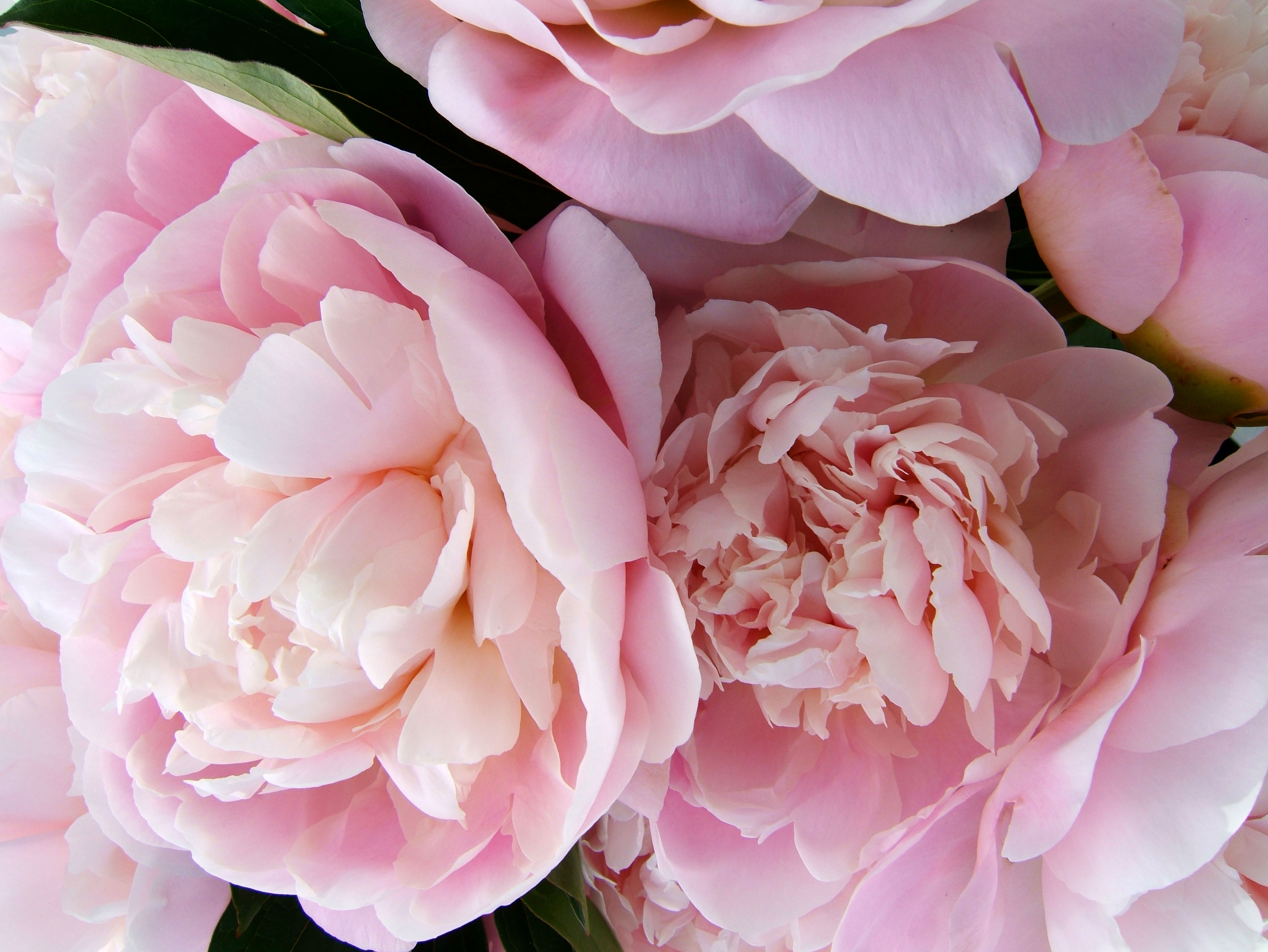

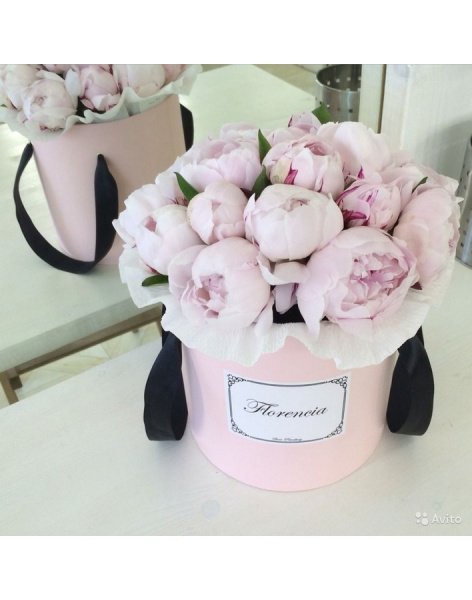




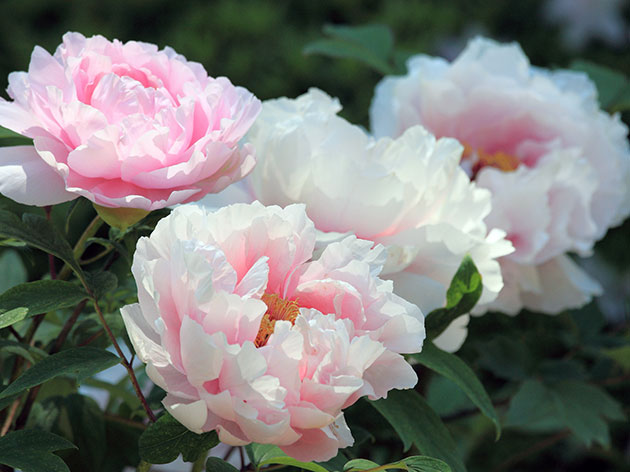

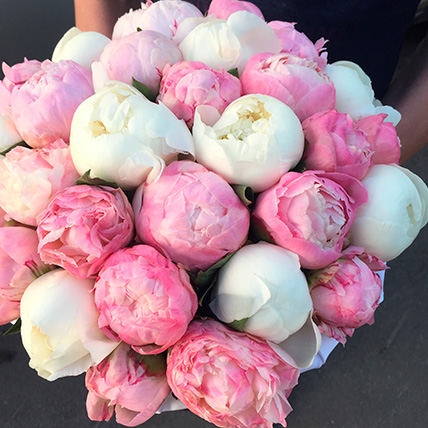
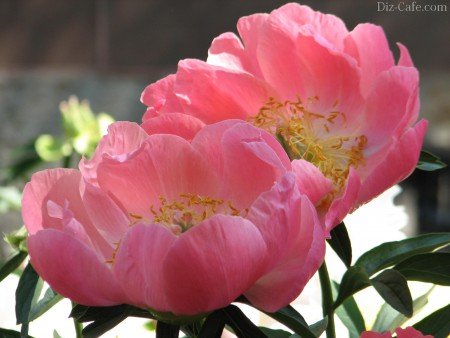
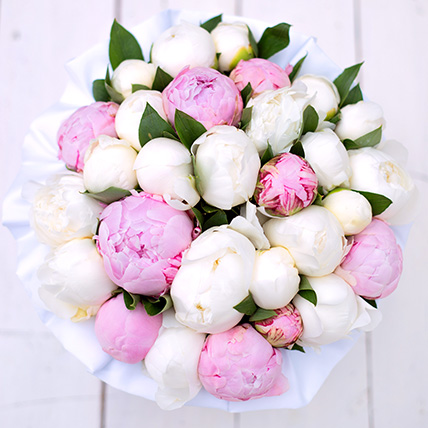
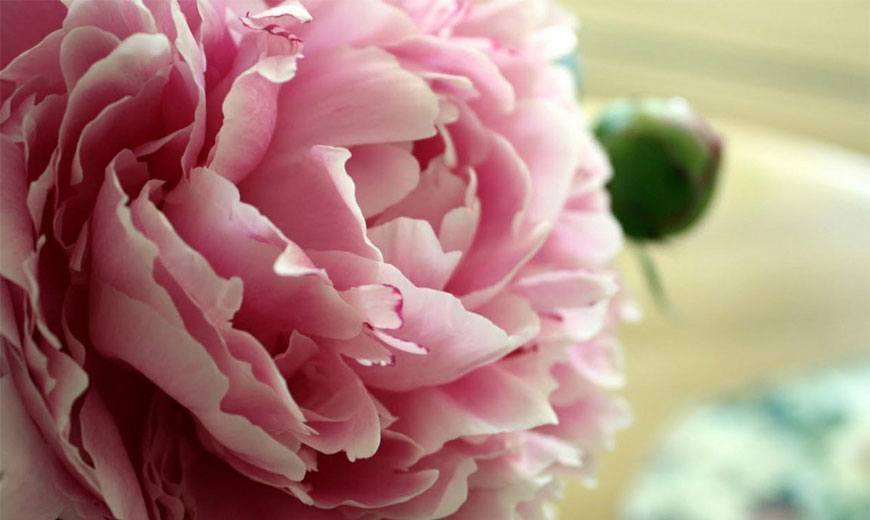
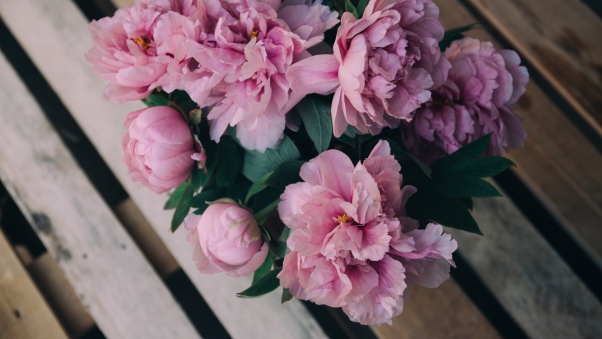
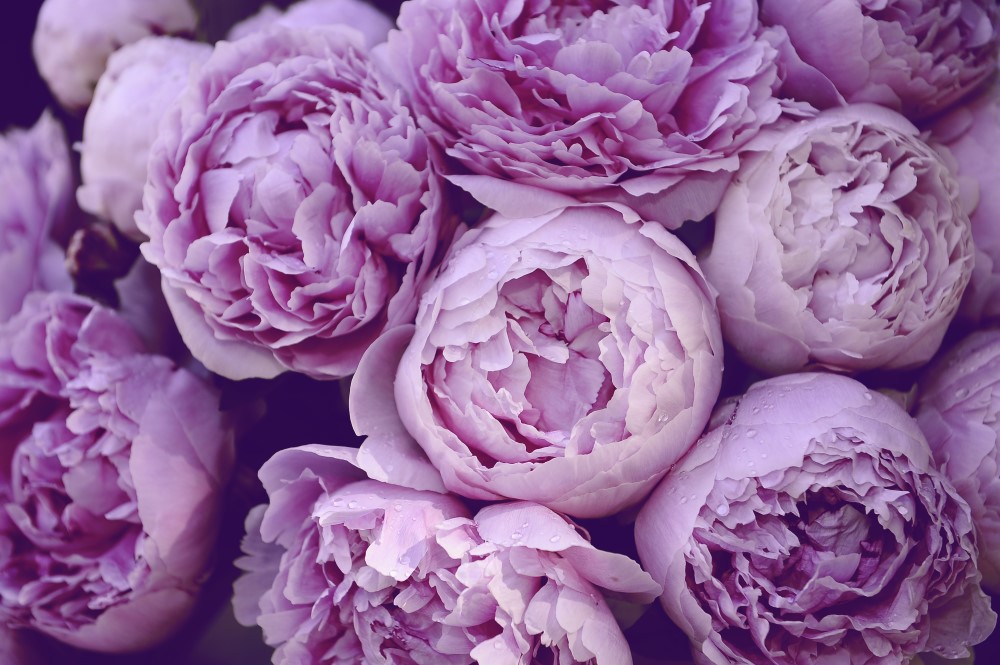
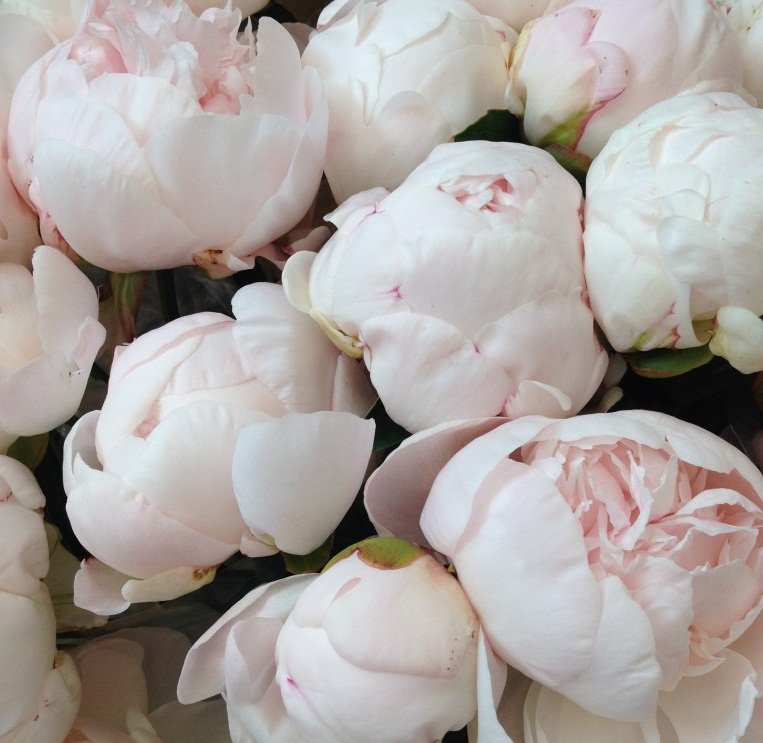
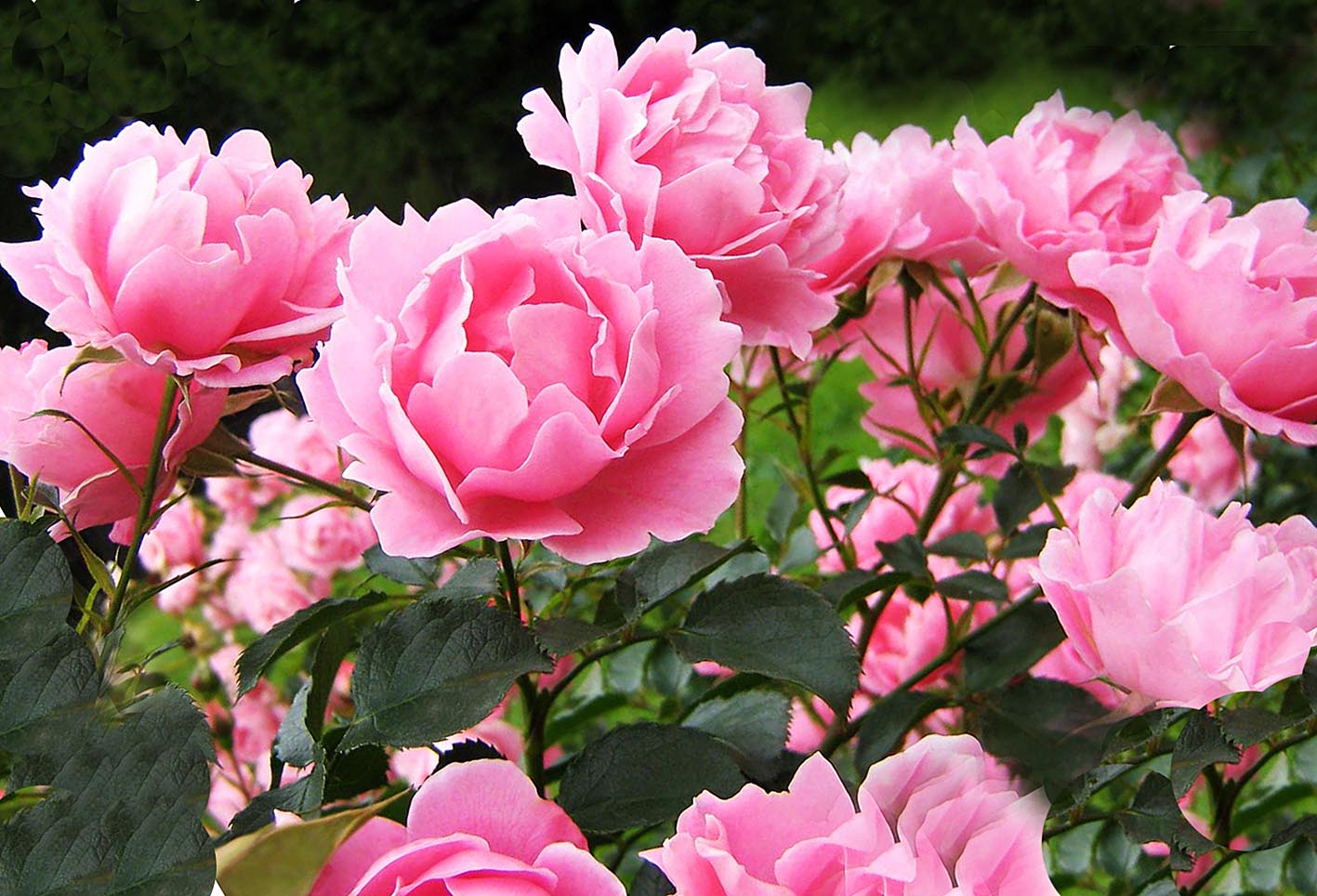

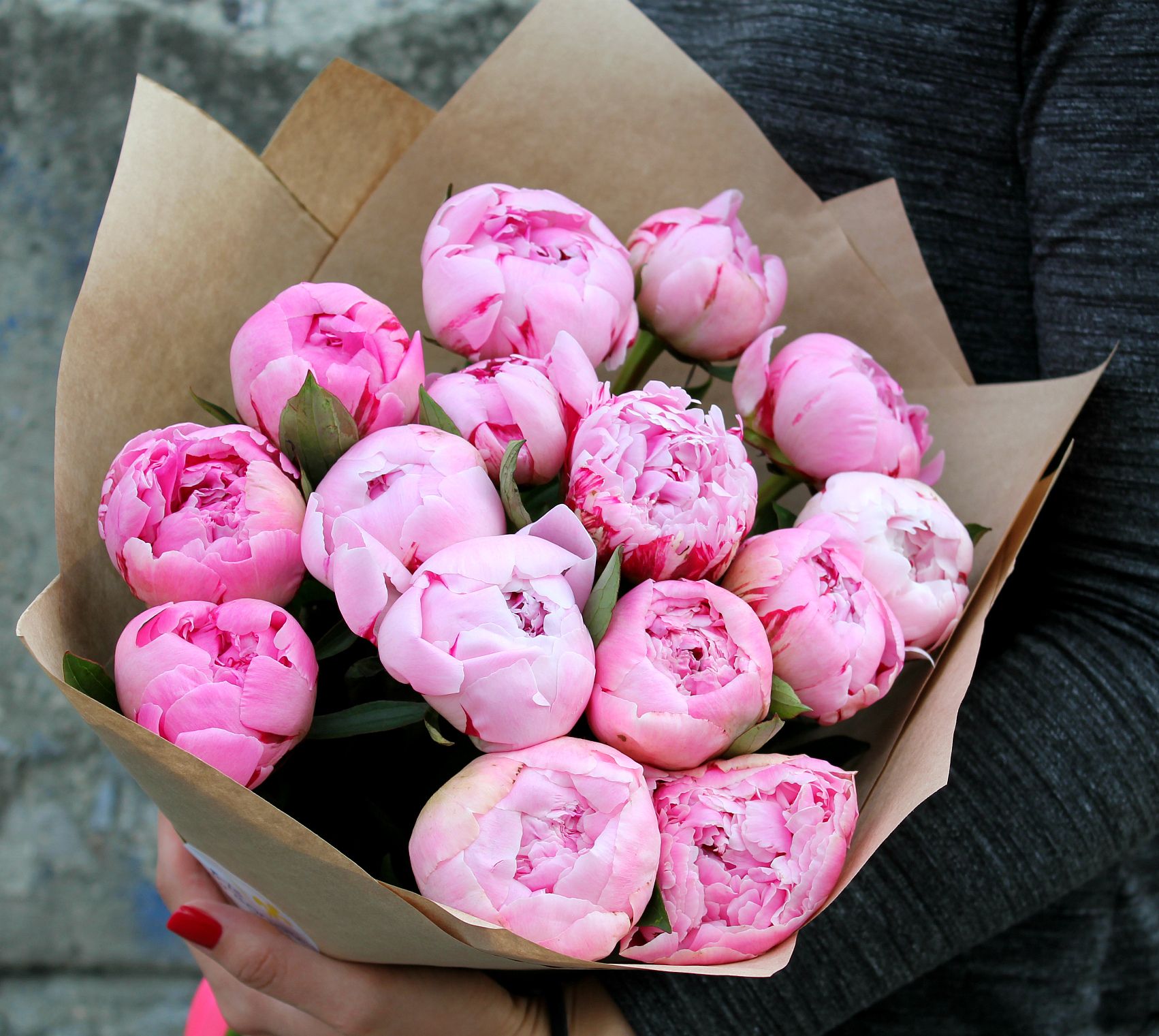


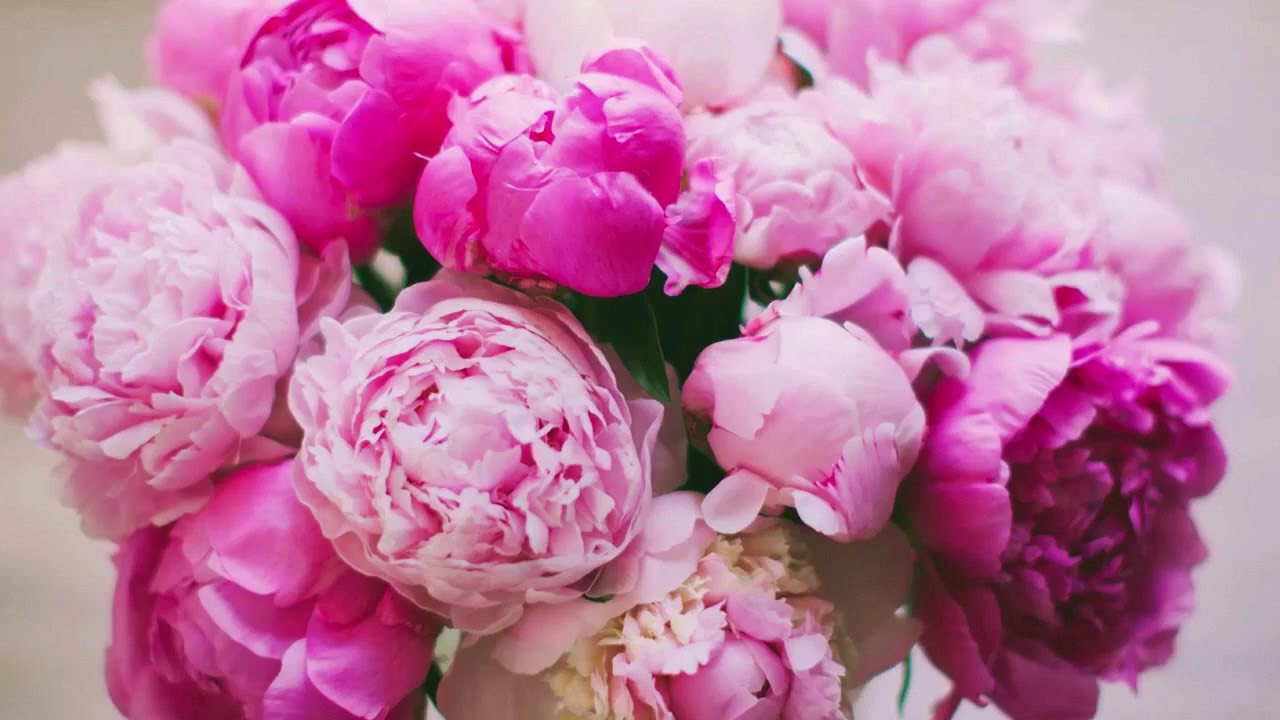
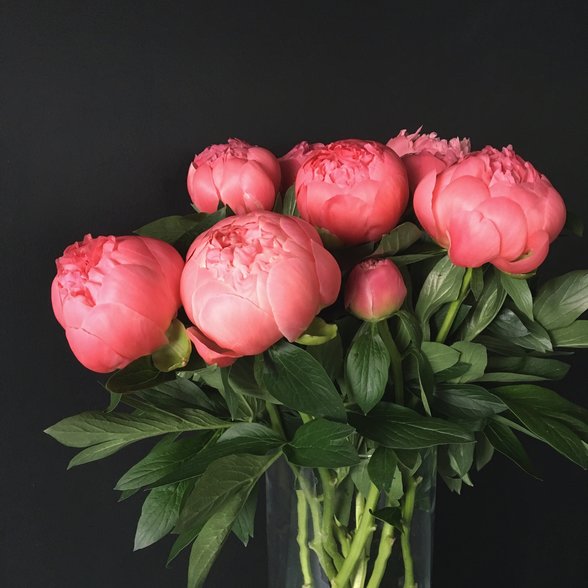

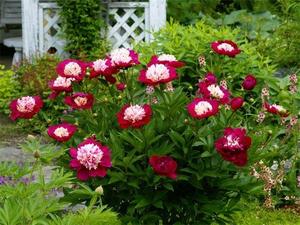 For good growth, the peony must be planted on right place. Landing takes place on:
For good growth, the peony must be planted on right place. Landing takes place on:
- sunny place or partial shade;
- place protected from drafts;
- on the open space away from trees and shrubs;
- from the house to the bush, at least 2 meters.
Before landing, 14 days in advance, it is necessary to prepare seat. The depth of the pit should be 70 cm, and the dimensions 60x60. The distance between the bushes is about a meter.
The soil must be fertilized. To do this, add to the ground organic fertilizer(rotted manure or compost). IN clay soil sand must be added to loosen the soil.

Pruning peonies for the winter
The main criterion is pruning the bush, to prepare the plant for future frosts.
When and how should a peony be cut?
Pruning of peonies must be done at the end of October, when the plant is preparing for "winter hibernation". Many growers prune the bush much earlier, but this can lead to weakening of the bush and poor flowering the next year.
If early pruning is necessary, the plant is left with a stem with 2-3 leaves. Thus, the bush will accumulate the necessary strength for the future budding.
Pruning rules:
- It is necessary to trim the stems, leaves and flowers;
- Leave the stem up to 5 cm long from the surface of the earth.
- Before pruning, the bush must be watered abundantly;
- All pruned shoots must be removed from the garden, as they can become a source of various diseases;
- After pruning, fertilizer must be applied to the soil: 200 grams of bone meal mixed with 300 grams of wood ash.
plant shelter
It is necessary to cover the plant in those regions where there are harsh winters to protect the root system. For this you can use:
- sawdust
- fallen leaves
- peat or compost
- coniferous paws
In no case should cut leaves or stems be used as a covering material, as this can lead to the appearance of fungal diseases. To protect against frost, the covering material must be at least 15 cm.
Shelter is necessary not only to protect the roots from frost, but also it brings the necessary nutrients to the soil. For adult plants - shelter is considered a good growth stimulator.
With the onset of spring, the shelter is removed, leaving only a small amount of mulch to prevent the growth of weeds.
With proper care and preparation for winter, the plant will delight with its flowering in the summer.
For beautiful and long flowering you need to know what peonies do not like:
- Highly moist soil, as excess water leads to root rot and plant death
- Plants are contraindicated in shaded places. In such places, the peony will not bloom and will quickly wither.
- You can not plant bushes next to trees and large shrubs. Since the roots of large plants will take away a lot of the nutrients that peonies need so much.
Do you know that:
In China, the peony is considered royal flower, and it was from there that the plant was brought to Europe. The Chinese people consider the peony to be a symbol of their culture. In Chinese literature and in painting, one can often find a combination of a peony with a butterfly.
The ancient Greeks knew the peony as medicinal plant. It was believed that this flower cures 20 diseases. Therefore, these beautiful flowers grew in every monastery. Until 1800, the plant was used only as medicinal plants and added to food.
Attention, only TODAY!
Despite the unpretentiousness of peonies, they still require minimal care - periodic watering, weeding, loosening the soil, top dressing. Since peonies are perennial, in autumn they require special care, the quality of which determines the splendor of flowering next year.
Autumn top dressing of peonies
Peonies are responsive to fertilization, which should be taken care of in the fall. Bushes are fed in September-October, which is determined by the growth and structure of pions. If you look at the roots of peonies, you will notice that in some places they are thickened. It is here that the nutrients supplied from the long roots accumulate. Even in autumn, the roots of peonies are actively growing, so they need additional feeding.
As a top dressing for peonies, a potassium-phosphorus mixture is used, since these elements are responsible for the development of new buds. You can feed the bushes with fertilizer granules or their solution. When using the dry method of top dressing, peonies are well watered beforehand, after which the fertilizer granules are carefully embedded in the soil. One peony bush will require 10-15 g of potassium and 15-20 g of phosphorus. Fertilizer should not get on the neck of the plant. The solution is prepared simply: a fertilizer tablet is dissolved in a bucket of water and a peony is poured over it.
Pruning a bush and preparing for wintering
In autumn, peony bushes are pruned without leaving this procedure for the spring, otherwise the shoots after the winter will become soft and difficult to cut with secateurs. Peony shoots are cut out in late autumn at the beginning of November. Pruning earlier is not recommended, as the plant will weaken, which will affect flowering next year. Experienced flower growers focus on frost. With their appearance, all the shoots of peonies lie on the soil, then they are carefully cut out.
Shoots should be cut at ground level, leaving no stumps. If dry weather has formed in autumn, peony bushes are plentifully watered with water before pruning. After cutting, all shoots and leaves are removed from the site and burned to prevent the development of diseases. It is not superfluous after pruning peonies to add 300 g of wood ash and 200 g of bone meal to the soil.
Preparing for winter - part of the autumn care of peonies
All events held in autumn with peony bushes are aimed at creating optimal conditions for wintering. This is especially necessary in areas where severe frosts are observed in winter. First of all, they check at what depth the peony buds are. The optimal depth is 3-6 cm, no more. If the distance is shorter, the peony planting site is sprinkled with a small layer of soil. For the winter, peonies are covered with fallen leaves, you can use sawdust, peat or compost. The leaves of the same plant cannot be used as a covering material, as you will create excellent conditions for the development of fungi. To protect peonies from severe frosts, the shelter must be at least 15 cm high.
Carrying out these simple activities will provide peonies with lush and beautiful flowering next year.
